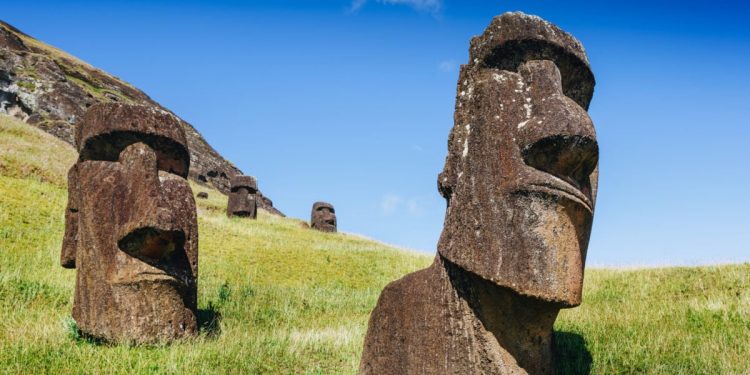Easter Island’s moai statues have long been an enigma to researchers who wondered how the ancient Rapa Nui people managed to move these enormous monoliths around the island. And now a team of anthropologists think they finally have the answer, thanks to some rather bizarre physics experiments.
In a recent article in the Journal of Archaeological Science, anthropologists Carl Lipo and Terry Hunt analyzed 962 moai statues, creating detailed, high-resolution 3D models to study their design and how they might have been transported.
From there, they designed an experiment to test whether a moai could “walk” from a quarry to its ceremonial platform, a theory they actually tested in the field.

They discovered that using ropes, teams of people could coax the statues into waddling in a zigzag motion: Just 18 people could “walk” a 4.35-ton moai replica about 330 feet (100 meters) in just 40 minutes. The demonstration, they argued, disproves previous theories that the Rapa Nui used wooden transportation devices to move their statues, or, wilder still, that they were relics of extraterrestrial civilizations.
“People have told all kinds of stories about things that are plausible or possible in one way or another,” Carl Lipo, lead author of the study and an anthropologist at Binghamton University, said in a statement. “But they never seek to evaluate the evidence to show that, in fact, you can learn about the past and explain the records that you see in a fully scientific way.”
Genius in the details
When creating 3D models of the moai, researchers identified several design features that could have made the statues suitable for transportation. Specifically, they noted that the statues tended to have a broad D-shaped base and a forward tilt (perhaps a product of their large, charming noses). They decided that the easiest way to make the statues “walk” would be to use a “vertical and tilting” motion, according to the newspaper.

The roads of Rapa Nui also support this hypothesis, the researchers add. These roads, about 15 feet wide with concave sections, appear “deliberately designed rather than accidentally,” meaning they were likely built specifically to help keep the moai stable during their “walks,” the anthropologists said.
But archaeological evidence also suggests that the moai themselves may have terraformed the roads, creating more bumps and bumps in the road for later moai statues to follow. “This engineering feature transforms what might otherwise be unpredictable movement over uneven terrain into controlled and directed progression along a prepared path,” the document notes.

“The physics makes sense,” Lipo said. “What we’ve seen experimentally actually works… Every time they move a statue, it looks like they’re tracing a route. The route is part of moving the statue. We actually see them overlapping and many parallel versions of them.”
Case closed?
The debate over the “correct” explanation for moai transport is surprisingly heated, and one section of the article is devoted entirely to rejecting alternative explanations.
However, the researchers say their “walking moai hypothesis” also aligns with oral traditions and songs from Rapa Nui that describe the moai as “walking” from the quarry. If the new theory is correct, it could reflect the songs of these ancient engineers.
“It shows that the Rapa Nui were incredibly intelligent. They figured it out,” Lipo said. “They’re doing it in a way that’s consistent with the resources that they have. So it’s really a credit to these people, saying, look what they’ve been able to achieve, and we have a lot to learn from them in these principles.”









